Watlington Nature Walk (Thursday 3rd June 2021)
- Watlington Climate Action Group

- Jun 16, 2021
- 2 min read
With next to zero knowledge of birds and nature in general, I took a day off work for this walk. This turned out to be a very enriching and an enchanting moment.
So on the most beautiful sunny and cool morning with horse chestnut flambeaux greeting us, six of us armed with binoculars and long lense cameras went for a four hour walk around Watlington Hill guided by enthusiastic wildlife lover and photographer Steve Gozdz. This is now Steve’s full-time occupation as interest in wildlife during the last twelve months has rocketed.
We started with Station Road where we learnt that with hedges and verges recently not being cut this has led to an increase in wildlife across the UK. Within minutes our attention was drawn to one of our usual suspects, a female red-kite perched on a telegraphic pole emitting its uniquely strident long call and identified that the female is bigger than the male and its head is egg shaped rather than rounded. Buzzards with their shorter and broader wings were seen circling in the distance close to the hills whilst linnets were dipping in and out of the open fields looking for seeds before rejoining their nest in the hedges.

The youngest participant, who had just completed his A’ levels and was in need of fresh air, had used this road many-a-time for long-boarding and boring family walks commented how he suddenly realised that he had never considered nature around him despite having spent so much time on this spot. His interest in biology was also reawakened with questions surrounding the survival of birds who nest in open-fields.

Along our way and as we climbed up and down ancient paths bordered by abundant moss by the Chalk Pits, we encountered herds of deers whilst the dawn chorus continued with the songs of yellowhammers, goldfinches, a fabulous goldcrest (the UK smallest bird as it weigh less than a 20p coin), a woodpecker, blue tits and blackcaps. Each had its particular call and song which Steve’s musicality could explain and replicate. We also saw badgers’ prints and holes, dog mercury (as the name suggests, do not eat it) and yew trees that are a great source of bird food as many insects live on them.
Through general chats, we found out that with warmer weather all year round, birds are more likely to stay in the same place or not travel as far. This made me wonder what implication this would have on the food chain in the various locations usually used by migrating birds.
Did you know? Little owls (we didn’t see any ) are not native to Britain but to Europe and were introduced to the country in the 19th century to combat a beetle plague which had led to two consecutive years of smaller crops and potential famine. Their numbers spread rapidly across the country and they became proportionally higher than on the continent as during the winter beetles can be found in Britain’s numerous and rich hedges. Sadly, their numbers are now in sharp decline.
Again thank you to Steve Gozdz and the Chilterns Walking Festival for this beautiful event.
Sophie Nelson (with comments borrowed from Hugh Thomson and Mervyn Randall)







Comments